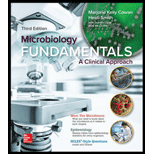
Microbiology Fundamentals: A Clinical Approach
3rd Edition
ISBN: 9781259709227
Author: Marjorie Kelly Cowan Professor, Heidi Smith
Publisher: McGraw-Hill Education
expand_more
expand_more
format_list_bulleted
Question
Chapter 1.3, Problem 17AYP
Summary Introduction
To list:
The three components of ATP
Introduction:
Adenosine monophosphate is formed of adenine nitrogenous bases, ribose base,anda phosphate group. It is also called
Expert Solution & Answer
Want to see the full answer?
Check out a sample textbook solution
Students have asked these similar questions
list the constituent unit of ATP .
What are the components and roles of ATP?
describe ATP
Chapter 1 Solutions
Microbiology Fundamentals: A Clinical Approach
Ch. 1.1 - List the various types of microorganisms that can...Ch. 1.1 - Describe the role and impact of microbes on the...Ch. 1.1 - Explain the theory of evolution and why it is...Ch. 1.1 - Explain the ways that humans manipulate organisms...Ch. 1.1 - Summarize the relative burden of human disease...Ch. 1.1 - Differentiate among bacteria, archaea, and...Ch. 1.1 - Identify an acellular infectious agent that is...Ch. 1.1 - Compare and contrast the relative sizes of the...Ch. 1.1 - Q.Can you think of a logical reason that a microbe...Ch. 1.1 - NCLEX PREP 1. For which of the following disease...
Ch. 1.2 - Make a time line of the development of...Ch. 1.2 - List some recent microbiology discoveries of great...Ch. 1.2 - Identify the important features of the scientific...Ch. 1.3 - Name the four main families of biochemicals.Ch. 1.3 - Provide examples of cell components made from each...Ch. 1.3 - Differentiate among primary, secondary, tertiary,...Ch. 1.3 - List the three components of a nucleotide.Ch. 1.3 - Name the three nitrogen bases of DNA and RNA.Ch. 1.3 - Prob. 17AYPCh. 1.3 - Recall three characteristics common to all cells.Ch. 1.3 - Q. Use context in the paragraph above to deduce...Ch. 1.3 - Prob. 2NPCh. 1.4 - Differentiate among the terms nomenclature,...Ch. 1.4 - Create a mnemonic device for remembering the...Ch. 1.4 - Correctly write the binomial name for a...Ch. 1.4 - Draw a diagram of the three major domains.Ch. 1.4 - Explain the difference between traditional and...Ch. 1 - Prob. 1QCh. 1 - Name six types of microorganisms that we are...Ch. 1 - Defend the argument that a web of life is a more...Ch. 1 - Which of the following is a macromolecule that...Ch. 1 - Prob. 5QCh. 1 - Imagine a way you might design a drug to destroy...Ch. 1 - Prob. 7QCh. 1 - Provide an argument about why metabolic...Ch. 1 - Provide a possible interpretation of the finding...Ch. 1 - DNA leads to RNA which can lead to the creation of...Ch. 1 - Compare and contrast the RNA molecule with the DNA...Ch. 1 - Suggest an argument for why eukaryotic cells have...Ch. 1 - Prob. 13QCh. 1 - Defend or refute this statement: Microbes intend...Ch. 1 - Coevolution is a term describing the influence...Ch. 1 - Which of the following processes can be the result...Ch. 1 - Speculate about why scientists believe there are...Ch. 1 - Prob. 18QCh. 1 - When a hypothesis has been thoroughly supported by...Ch. 1 - Defend the use of complicated-sounding names for...Ch. 1 - Identify the most important component of the...Ch. 1 - Figure 1.2 Look at the red bat (the time that...
Knowledge Booster
Similar questions
arrow_back_ios
SEE MORE QUESTIONS
arrow_forward_ios
Recommended textbooks for you
 Principles Of Radiographic Imaging: An Art And A ...Health & NutritionISBN:9781337711067Author:Richard R. Carlton, Arlene M. Adler, Vesna BalacPublisher:Cengage Learning
Principles Of Radiographic Imaging: An Art And A ...Health & NutritionISBN:9781337711067Author:Richard R. Carlton, Arlene M. Adler, Vesna BalacPublisher:Cengage Learning

Principles Of Radiographic Imaging: An Art And A ...
Health & Nutrition
ISBN:9781337711067
Author:Richard R. Carlton, Arlene M. Adler, Vesna Balac
Publisher:Cengage Learning